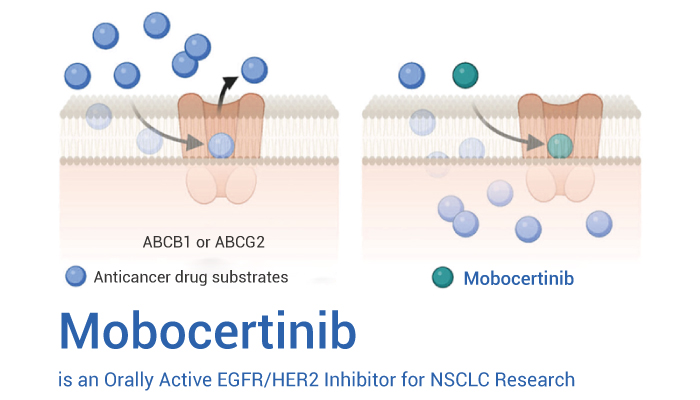The epidermal growth factor receptor (EGFR; ErbB-1; HER1 in humans) is a transmembrane protein. And it is a receptor for members of the epidermal growth factor family (EGF family) of extracellular protein ligands
The EGFR family of receptor tyrosine kinases (RTK) comprises four distinct receptors. They are the EGFR (also known as ErbB-1/HER1), ErbB-2 (neu, HER2), ErbB-3 (HER3) and ErbB-4 (HER4). The ErbB family of receptor tyrosine kinases (RTKs) couples binding of extracellular growth factor ligands to intracellular signaling pathways regulating diverse biologic responses. For example, proliferation, differentiation, cell motility, and survival. The three best characterized signaling pathways induced through ErbBs are Ras-mitogen-activated protein kinase (Ras-MAPK), phosphatidylinositol 3 kinase-protein kinase B (PI3K-PKB/Akt), and phospholipase C-protein kinase C (PLC-PKC) pathways.
Mobocertinib is an Orally Active EGFR/HER2 Inhibitor for NSCLC Research
Mobocertinib (TAK-788) is an orally active and irreversible EGFR/HER2 inhibitor for NSCLC research. And it potently inhibits oncogenic variants containing activating EGFRex20ins mutations with selectivity over wild-type EGFR.
In Vitro, Mobocertinib (1.5 nM-10 μM; 7 days) inhibits LU0387 (NPH) cells with IC50 of 21 nM. Mobocertinib (2 h) potently inhibits EGFR with common activating mutations (HCC827 (D), HCC4011 (L)) or with a T790M mutation (H1975 (LT)) more potently than WT EGFR (A431 (WT)). TAK-788 (0.1 nM-1 μM; 6 h) inhibits pEGFR and pERK1/2 in CUTO14 (ASV) cells. Mobocertinib (0.3 nM-1 μM; 6 h) inhibits EGFR and downstream signaling. Mobocertinib (0.01, 0.1 and 1 μM; 6 h) inhibits HER2 signaling in H1781 (HER2 Exon 20G776>VC), Ba/F3 (HER2 exon 20YVMA) cells. In Vivo, Mobocertinib (3, 10, 30 mg/kg; p.o.; once daily for 20 days) significantly induces tumor growth inhibition.
In conclusion, Mobocertinib (TAK-788) is an orally active and irreversible EGFR/HER2 inhibitor for NSCLC research.
Reference:
[1]. Cancer Discov. 2021 Jul;11(7):1672-1687.
[2]. Cancer Res. 2021 Oct 15;81(20):5311-5324.
